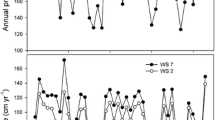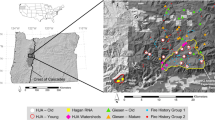Abstract
Despite the widely recognized importance of disturbance in accelerating the loss of elements from land, there have been few empirical studies of the effects of natural disturbances on nitrogen (N) dynamics in forest ecosystems. We were provided the unusual opportunity for such study, partly because the intensively monitored watersheds at the Hubbard Brook Experimental Forest (HBEF), New Hampshire, experienced severe canopy damage following an ice storm. Here we report the effects of this disturbance on internal N cycling and loss for watershed 1 (W1) and watershed 6 (W6) at the HBEF and patterns of N loss from nine other severely damaged watersheds across the southern White Mountains. This approach allowed us to test one component of N limitation theory, which suggests that N losses accompanying natural disturbances can lead to the maintenance of N limitation in temperate zone forest ecosystems. Prior to the ice storm, fluxes of nitrate (NO3 −) at the base of W1 and W6 were similar and were much lower than N inputs in atmospheric deposition. Following the ice storm, drainage water NO3 − concentrations increased to levels that were seven to ten times greater than predisturbance values. We observed no significant differences in N mineralization, nitrification, or denitrification between damaged and undamaged areas in the HBEF watersheds, however. This result suggests that elevated NO3 - concentrations were not necessarily due to accelerated rates of N cycling by soil microbes but likely resulted from decreased plant uptake of NO3 -. At the regional scale, we observed high variability in the magnitude of NO3 - losses: while six of the surveyed watersheds showed accelerated rates of NO3 − loss, three did not. Moreover, in contrast to the strong linear relationship between NO3 − loss and crown damage within HBEF watersheds [r 2: (W1 = 0.91, W6 = 0.85)], stream water NO3 − concentrations were weakly related to crown damage (r 2 = 0.17) across our regional sites. The efflux of NO3 − associated with the ice storm was slightly higher than values reported for soil freezing and insect defoliation episodes, but was approximately two to ten times lower than NO3 − fluxes associated with forest harvesting. Because over one half of the entire year’s worth of N deposition was lost following the ice storm, we conclude that catastrophic disturbances contribute synergistically to the maintenance of N limitation and widely observed delays of N saturation in northern, temperate zone forest ecosystems.








Similar content being viewed by others
References
J Aber KJ Nadelhoffer P Steudler JM Melillo (1989) ArticleTitleNitrogen saturation in northern forest ecosystems. BioScience 39 378–86
J Aber W McDowell K Nadelhoffer A Magill B Berntson M Kamakea S McNulty W Currie L Rustad I Fernandez (1998) ArticleTitleNitrogen saturation in temperate forest ecosystems—hypotheses revisited. BioScience 48 921–34
JD Aber CT Driscoll (1997) ArticleTitleEffects of land use, climate variation, and N deposition on N cycling and C storage in northern hardwood forests. Global Biogeochem Cycles 11 639–48 Occurrence Handle1:CAS:528:DyaK2sXnsleksbc%3D
[APHA] American Public Health Association. 2000. Standard methods for the examination of water and wastewater. 15th ed. Washington, DC: American Public Health Association.
FH Bormann GE Likens (1979) Pattern and Process of a Forested Ecosystem. Springer-Verlag New York
JL Campbell JW Hornbeck WH McDowell DC Buso JB Shanley GE Likens (2000) ArticleTitleDissolved organic nitrogen budgets for upland, forested ecosystems in New England. Biogeochemistry 49 123–42 Occurrence Handle10.1023/A:1006383731753 Occurrence Handle1:CAS:528:DC%2BD3c**s1yjt7g%3D
JE Compton RD Boone (2000) ArticleTitleLong-term impacts of agriculture on soil carbon and nitrogen in New England forests. Ecology 81 2314–30
RA Dahlgren CT Driscoll (1994) ArticleTitleThe effects of whole-tree clear-cutting on soil process at the Hubbard Brook Experimental Forest. New Hampshire, USA. Plant Soil 158 239–62 Occurrence Handle1:CAS:528:DyaK2c**s12jtb8%3D
KN Eshleman RP Morgan JR Webb FA Deviney JN Galloway (1998) ArticleTitleTemporal patterns of nitrogen leakage from mid-Appalachian forested watersheds: Role of insect defoliation. Water Resources Res 38 2005–116
JN Galloway WH Schlesinger H Levy A Michaels JL Schnoor (1995) ArticleTitleNitrogen fixation—anthropogenic enhancement—environmental response. Global Biogeochem Cycles 9 235–52 Occurrence Handle1:CAS:528:DyaK2MXmtlWlt7g%3D
CL Goodale JD Aber WH McDowell (2000) ArticleTitleThe long-term effects of organic and inorganic nitrogen export in the White Mountains, New Hampshire. Ecosystems 3 433–50
CL Goodale JD Aber (2001) ArticleTitleThe long-term effects of land-use history on nitrogen cycling in northern hardwood forests. Ecol Appl 11 253–67
PM Groffman JP Hardy S Nolan RD Fitzhugh CT Driscoll TJ Fahey (1999) ArticleTitleSnow depth, soil frost and nutrient loss in a northern hardwood forest. Hydrol Process 13 2275–86
PM Groffman CT Driscoll TJ Fahey JP Hardy RD Fitzhugh GL Tierney (2001) ArticleTitleColder soils in a warmer world: A snow manipulation study in a northern hardwood forest ecosystem. Biogeochemistry 56 135–50 Occurrence Handle10.1023/A:1013039830323 Occurrence Handle1:CAS:528:DC%2BD38XhtFajtL0%3D
LO Hedin JJ Armesto AH Johnson (1995) ArticleTitlePatterns of nutrient loss from unpolluted, old-growth temperate forests: evaluation of biogeochemical theory. Ecology 76 493–509
WE Holmes DR Zak (1999) ArticleTitleSoil microbial control of nitrogen loss following clearcut harvest in northern hardwood ecosystems. Ecol Appl 1 202–15
JW Hughes TJ Fahey (1994) ArticleTitleLitterfall dynamics and ecosystem recovery during forest development. Forest Ecol Manage 63 181–98 Occurrence Handle10.1016/0378-1127(94)90110-4
CE Johnson CT Driscoll TG Siccama GE Likens (2000) ArticleTitleElement fluxes and landscape position in a northern hardwood forest watershed ecosystem. Ecosystems 3 159–84
J Kaiser (2001) ArticleTitleThe other global pollutant: Nitrogen proves tough to curb. Science 294 1268–69 Occurrence Handle10.1126/science.294.5545.1268 Occurrence Handle1:CAS:528:DC%2BD3MXotlKntrY%3D Occurrence Handle11701908
Lewis, GP. 1998. Response of Stream Chemistry to Forest Insect Defoliation on the Allegheny High Plateau, Pennsylvania. Ph.D. Dissertation. Cornell University, Ithaca, NY.
GP Lewis GE Likens (2000) ArticleTitleLow stream nitrate concentrations associated with oak forests on the Allegheny High Plateau of Pennsylvania. Water Resources Res 36 3091–94 Occurrence Handle1:CAS:528:DC%2BD3cXnsVKjt7g%3D
GE Likens FH Bormann NM Johnson DW Fisher RS Pierce (1970) ArticleTitleEffects of forest cutting and herbicide treatment on nutrient budgets in the Hubbard Brook watershed ecosystem. Ecol Monogr 40 23–47
GE Likens FH Bormann (1995) Biogeochemistry of a Forested Ecosystem. Springer-Verlag New York
GE Likens FH Bormann RS Pierce WA Reiners (1978) ArticleTitleRecovery of a deforested watershed. Science 199 492–6 Occurrence Handle1:CAS:528:DyaE1cXhtVeqtbY%3D
CW Martin CT Driscoll TJ Fahey (2000) ArticleTitleChanges in streamwater chemistry after 20 years from forested watersheds in New Hampshire. Can J Forest Res 30 1206–13 Occurrence Handle10.1139/cjfr-30-8-1206 Occurrence Handle1:CAS:528:DC%2BD3cXntFOltr8%3D
MJ Mitchell CT Driscoll JS Kahl GE Likens PS Murdoch LH Pardo (1996) ArticleTitleClimatic control of nitrate loss from forested watersheds in the northeast United States. Environ Sci Technol 30 2609–12 Occurrence Handle1:CAS:528:DyaK28XjslOiu74%3D
T Näsholm A Ekblad A Nordin R Giesler M Högberg P Högberg (1998) ArticleTitleBoreal forests take up organic nitrogen. Nature 392 914–6 Occurrence Handle10.1038/31921
SV Olinger ML Smith ME Martin RA Hallett CL Goodale JD Aber (2002) ArticleTitleRegional variation in forliar chemistry and N cycling among forests of diverse history and composition. Ecology 83 339–55
LH Pardo CT Driscoll GE Likens (1995) ArticleTitlePatterns of nitrate loss from a chronosequence of clear-cut watersheds. Water Air Soil Pollut 85 1659–64 Occurrence Handle1:CAS:528:DyaK28**t1eisr4%3D
SS Perakis LO Hedin (2002) ArticleTitleNitrogen loss from unpolluted South American forests mainly via dissolved organic compounds. Nature 415 416–9 Occurrence Handle10.1038/415416a Occurrence Handle11807551
Rhoads AG, Hamburg S, Fahey TJ, Siccama T, Hane E, and others. 2002. Effects of an intense ice storm on the structure of a northern hardwood forest. Can J Forest Res 32:1763–1775.
WT Swank JB Wade DA Crossley Jr RL Todd (1981) ArticleTitleInsect defoliation enhances nitrate export from forest ecosystems. Oecologia 51 2977–99
MA Tabatabai WA Dick (1983) ArticleTitleSimultaneous determination of nitrate, chloride, sulfate and phosphate in natural waters by ion chromatography. J Environ Qual 12 209–13 Occurrence Handle1:CAS:528:DyaL3s**t1Wms7o%3D
GL Tierney TJ Fahey PM Groffman JP Hardy RD Fitzhugh CT Driscoll (2001) ArticleTitleSoil freezing alters fine root dynamics in a northern hardwood forest. Biogeochemistry 56 175–90 Occurrence Handle10.1023/A:1013072519889 Occurrence Handle1:CAS:528:DC%2BD38XhtFajtLo%3D
N van Breeman (2002) ArticleTitleNatural organic tendancy. Nature 415 381–382 Occurrence Handle10.1038/415381a Occurrence Handle11807536
PM Vitousek JR Gosz CC Grier JM Melillo WA Reiners (1982) ArticleTitleA comparative analysis of potential nitrification and nitrate mobility in forest ecosystems. Ecol Monogr 52 155–77 Occurrence Handle1:CAS:528:DyaL38Xkt1aktrc%3D
PM Vitousek RW Howarth (1991) ArticleTitleNitrogen limitation on land and in the sea: How can it occur? Biogeochemistry 13 87–115
PM Vitousek LO Hedin PA Matson JH Fownes J. Neff (1998) Within-system element cycles, input–output budgets, and nutrient limitation. M Pace P Groffman (Eds) Successes limitations and frontiers in ecosystem science Springer-Verlag Berlin
Acknowledgements
We are grateful to Frank Berondse and three anonymous revisners for helpful common on this paper. We are thankful to K. Wiley, B. Dresser, C. Wood, Adam Welman, and Jason Demers for sample collection and/or analysis. This study was supported by the National Science Foundation through the LTER and LTREB programs. We are indebted to the USDA Forest Service for use of precipitation and hydrology data. The Hubbard Brook Experimental Forest is operated and maintained by the USDA Forest Service. This is a contribution to the Hubbard Brook Ecosystem Study.
Author information
Authors and Affiliations
Corresponding author
Rights and permissions
About this article
Cite this article
Houlton, B., Driscoll, C., Fahey, T. et al. Nitrogen Dynamics in Ice Storm-Damaged Forest Ecosystems: Implications for Nitrogen Limitation Theory . Ecosystems 6, 431–443 (2003). https://doi.org/10.1007/s10021-002-0198-1
Received:
Accepted:
Published:
Issue Date:
DOI: https://doi.org/10.1007/s10021-002-0198-1




